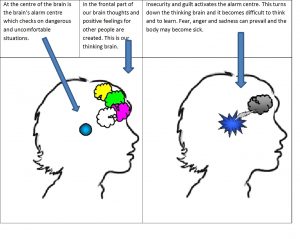The Thinking Brain and the Alarm Centre
Here you can read about how your brain works when all is well and when things go wrong:

(The brain pictures can be printed here)
Hyper-sensitivity in the alarm centre of the brain
Unpleasant and dangerous situations can cause the alarm centre to be hyper-sensitive. This means that the next time you are in a situation that resembles the ‘dangerous situation’ the alarm centre may overreact with the result that you become afraid, angry or sad – perhaps without any reason at all. It becomes difficult to think rationally. Instead you react instinctively to ‘survive’ mentally and socially.
It’s obviously good that the alarm centre by nature takes over when we are facing real danger. If your life is at risk there is no time to consider the pros or cons of taking action. You have to react prompt with fight or flight. However, it is not so desirable if the thinking brain turns down when there is no serious danger to you. An example is when you go blank in an exam situation, or when you panic about something that in fact is not dangerous at all. If your alarm centre has become over-sensitive it can be provoked just by thinking about the unpleasant situation. It’s like riding a mind-train that is running way too fast. (read the Story about a Thought-Train).
The only thing you learn when you are alarmed is to be on guard in similar situations. You don’t get more resilient, but you are at risk of getting more vulnerable. Thoughts about your psychological and social survival will dominate your thinking. Vulnerability can be seen as anger, fear and sadness. If you on the other hand get overprotected and do not face any challenges, your alarm center will believe that everything is ‘dangerous’ which makes you vulnerable as well.
Very unpleasant and dangerous situations (traumas, accidents and assaults) of course increase the risk of oversensitizing the alarm centre. Unfortunate micro-events can, by chance, also create permanent over-sensitivity in the alarm system (e.g. a horror movie).
The most frequent cause of imbalance in the alarm center is insecurity in everyday life (micro-bullying) for example within family, in school or at work – and stress at a level that overloads the working memory and causes loss of overview.
The invisible
Other people’s thoughts are invisible. That’s why we sometimes misunderstand another person and believe that he or she has bad intentions towards us. Such thoughts can trigger the alarm centre. If the other person is in an alarm state as well we have two alarmed brains fighting each other and/or fleeing from each other.
The resilient brain
Fortunately the brain can be trained to become resilient instead of becoming vulnerable. If the thinking brain and the alarm centre face appropriate challenges – neither to big nor too small, the thinking brain is able to control the alarm centre in a way that the alarm is not triggered without reason. The brain’s working memory is trainable too, thus making it easier to cope with life (read more: Resilience and Praise).
The human animal
Humans and animals have the alarm centre in common whereas the thinking brain is solely human. When people get annoyed and argue we get more ‘animal like’ because we turn up the volume of the alarm centre and turn down the volume of the thinking brain. This happens for instance if we feel personally affected by a critical or wounding remark.
It is easy to discover when you are about to fall in to the ‘alarm trap’. As soon as you experience the alarm feelings e.g. anger, irritation, hurt, fear, panic ect., you are on that path. Then it is easy to react with fight or flight – we use words (or violence) to defend ourselves or we flee:
- We walk away – or start doing something else to escape the feelings and the situation.
- We say nothing – we ‘hide’.
- We explain it away – to others or to ourselves (Read more: self-deception)
- We soothe our feelings with chemistry, for example food, sugar or stimulants.
When we get ‘animal like’ we really need to take care in order to escape the alarm-trap. Many of the simple exercises at the website can help you, of course if practiced enough to becomean automatic reaction when difficult situations arise. Often just a small, simple, quiet and patient question can in fact help a person who is at the mercy of his og her emotions:
”Tell me what is happening inside you right now…”
Describing how we feel inside, activates the thinking part of the brain instantly … and we are already on the way out being animal-like.
If a person is very emotional, reasonable arguments are rarely of any use, as the volume of the thinking brain is turned down. The only helpful things in that situation are: silence, care and protection – until things inside calm down inside and the thinking brain is again turned on .
Read more:
Examples of where We get Trapped in the Alarm Centre
Acute Crisis – Protect the Alarm Centre
How to Calm Down the Alarm Centre.
A very good idea for children:
- Tell the child about the alarm centre of the brain – encourage the child to draw/build its own alarm centre as he or she imagines it in his og her mind.
- Talk about situations where the child’s alarm centre switch on – for better or worse – and stimulate the child to come up with good things to do, when it happens.
This gives the child an understanding of, and possible actions to take, regarding an important part of its inner system, namely the alarm centre.
